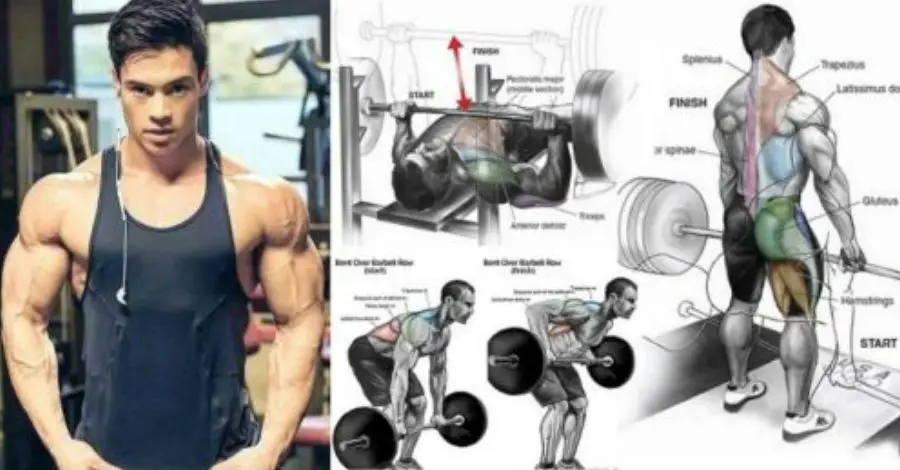Resistance training is more important and far more effective than cardio for fat loss, and is an essential part of your training programme. There are eight essential exercises that everyone should include in their resistance training programme.
So, you want to get lean; be ripped? You have your nutrition targeted at fat loss; you have your supplement regimen all ready. Now, you just need your training program sorted, and you will be ready to roll.
How do you train for fat loss? What are the best exercises to include? What is the best split to use? How much cardio do you do? How many recovery days do you take?
The information available is varied and often contradictory, because what works for one individual does not always work for another. If that is the case, how does one go about setting up a training routine if everyone responds differently to different training programme?
While everyone has their own methods of training for fat loss, there are several training methods, techniques and exercises that work effectively for everyone, no matter who they are, or what their training history is. Resistance training is an essential part of training for fat loss, and is far more effective than doing cardio—in fact, you do not even have to do cardio to get ripped!
There are eight exercises that everyone should include in their resistance training programme:
- Squat
- Deadlift
- Power Clean
- Bench Press
- Reverse Bent Over Row
- Pull-Ups
- Military Press
- Dips
Recommended Sets/Reps: 3 sets of 12 reps are recommended for each exercise, resting for 30 seconds in-between sets to maintain intensity and elevated heart rate for optimal fat loss.
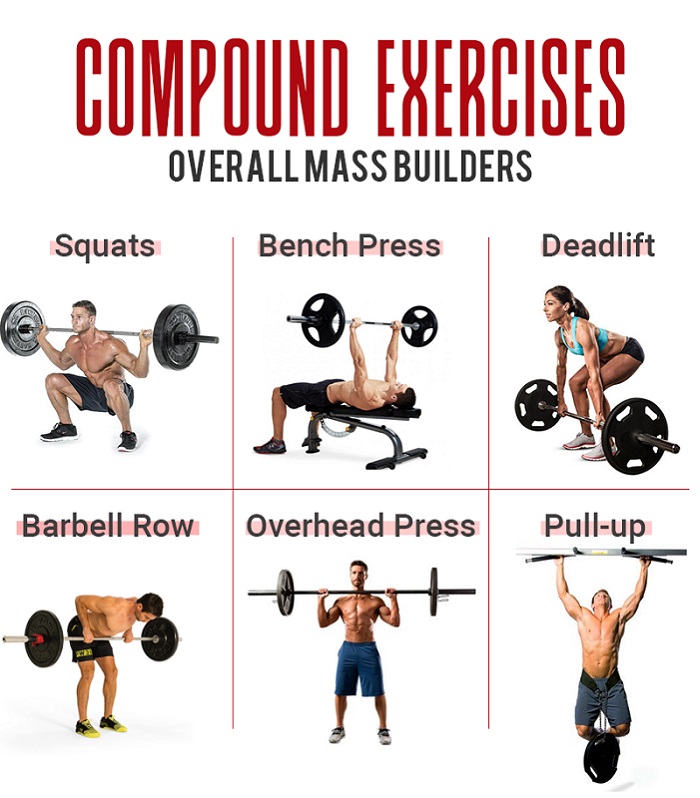
Every exercise is a compound, multi-joint exercise, ensuring that your training sessions are as effective and efficient as possible for fat loss, by recruiting multiple body-parts, including those that are not able to be exhausted in the same way with isolation exercises.
Ironically, these exercises are the same ones that will help you build the most muscle mass—the only difference is the number of sets and reps, and the recovery period between sets used.
This article will briefly discuss each exercise, as well as provide an example of training splits for both the new and experienced trainee.
1. Squat
Squats hit most muscle groups in the body, with emphasis on the core and large lower body muscles. The more muscle mass and motor units recruited during an exercise, the better the exercise for burning body fat.
You can incorporate variations of the squat, in order to target different muscles more specifically: The front squat focuses more on the quadriceps, whereas the back squat (recommended over the front squat, because it recruits more muscle activation) works the gluteals and hamstrings more.

Changing the width of your stance during squats will also affect which muscles are worked more: A narrow stance is going to hit the quadriceps more, whereas a wide stance is going to concentrate on the gluteals and hamstrings, and the sumo stance the adductors.
You can use barbells, dumbbells, Swiss balls, and even just body weight, to perform squats. Whether you use free weights (i.e. barbells and dumbbells) or machines (i.e. the Smith machine and hack squat) also determines the effectiveness of the squat, with barbells being superior to the rest.
Ideally, when performing the squat, you want to go down until your thighs are parallel to the ground; however, some individuals cannot do this (i.e. taller or long-limbed individuals), and so going as far as you can comfortably is adequate, if your form is correct and the intensity high enough.
2. Deadlift
The deadlift hits not just the back, but the entire core, recruiting and strengthening the large lower body muscles, from the shoulder girdle down to your hips and legs, with emphasis on the gluteus maximus, quadriceps, hamstrings, hips, and abdominals, strengthening and stabilising the erector spinae and lower back.
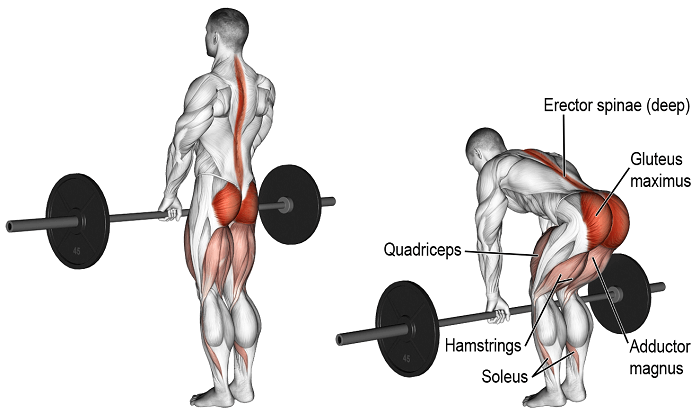
This exercise is very important, as the lower back is usually a very weak area on most, which in turn creates instability, injuries, and other issues. Depending on your forearm and grip strength, you can use straps to hold your grip to the barbell when you start moving heavier weights.
Otherwise, there are several hand positions you can use—both hands pronated (i.e. overhand), an alternate grip (this helps strength) with one hand pronated and the other supinated (i.e. underhand).
3. Power Clean
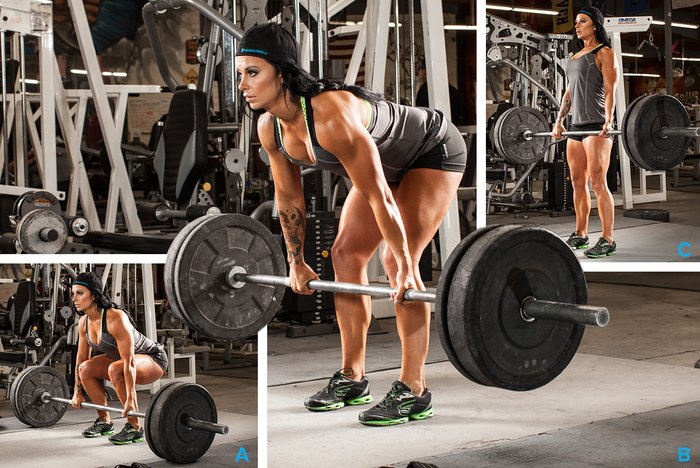
Similar to the deadlift in the muscles recruited—but without the ability to lift as heavy loads—the power clean is a compound power exercise that works the lower legs, quadriceps, gluteals, upper back, and deltoids. Not surprisingly, it is the power exercises that are the most effective exercises to use, and although the power clean is a difficult exercise, if done correctly, can be a real asset in your assault on fat loss.
4. Bench Press
Another power exercise, the bench press is the primary exercise used to work the pectorals (and to some extent, the anterior deltoids and triceps). As with the squat, the bench press can be performed with many variations to target areas of the chest.
More specifically, using the flat bench will hit the middle of the chest, using an incline bench press will work the upper pectorals (and serratus anterior), whilst a decline bench press will hit the lower pectorals. Again, either dumbbells or a barbell can be used with this exercise, with the barbell preferable, even though using dumbbells requires more stability.
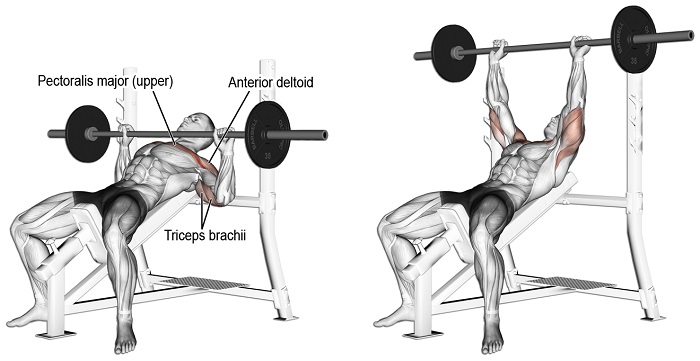
Changes in grip width can also affect which muscles are hit more—a wider grip will focus more on the chest itself, whereas a narrow grip will target the triceps more (making that variation an excellent exercise to do when focusing on the triceps).
5. Reverse Bent Over Row
Next to the lower body, the back is the biggest upper body muscle group, encompassing the entire area from the top of the trapezius down to the hips. Counterbalancing the bench press, the bent over row works the back. Even better than the traditional bent over row is the reverse bent over row, as it recruits more muscles than the former.

A pronated grip should be used, and depending on the width of your grip, you can target the rhomboids or latissimus dorsi. A wider grip is going to hit the latissimus dorsi more, whereas a narrower grip will target the rhomboids. Feet can remain on the ground, or elevated on a bench to increase the intensity of the exercise.
6. Pull-Ups
After reverse bent over rows, pull-ups are the most complete exercise for back development—especially for the latissimus dorsi—and you hit every part of your back, from the wide part of your trapezius and latissimus dorsi, tapering down to your waist and lower back, just by using a combination of pull-up variations.
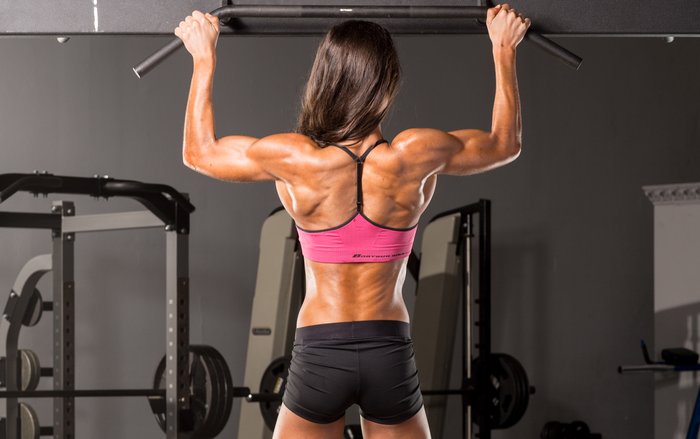
There are so many variations of pull-ups that can be done, from using full body weight to the assisted machine, to even adding weight in the form of extra plates from a chain on a weight belt. You have close or wide-grip options, with your hands in a neutral, pronated, or supinated position.
You can do half-reps (focus—although on the back—includes more emphasis on the biceps), complete pull-ups (with elbows to full extension), or sternum pull-ups (where you keep going up until your sternum touches the bar).
7. Military Press
Also called a shoulder press, the military press targets the deltoids, and is generally done in a standing position—that way it forces the trainee to stabilise their core, instead of being able to use the bench for support (as they would in a seated military press).
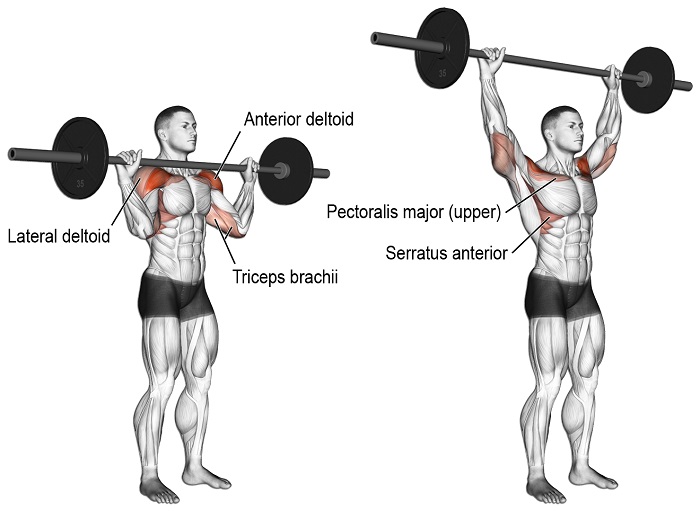
As with the squat, deadlift, and reverse bent over row, the core is activated during the military press; barbells or dumbbells can be used, with a barbell preferable, as unilateral movements can sometimes lead to muscle and strength imbalances.
There are in front of the head and behind the head presses; behind the head presses are for the experienced trainee only, due to the increased risk for injury if the exercise is performed incorrectly.
8. Dips
Dips are the best exercise you can do for your triceps. Beginners can start off doing bench dips – dips with their hands on a bench, their feet on the floor. Graduate to body weight dips on the dip bars. The experienced trainee can add weight to their dips by either holding a dumbbell between their feet or hanging a plate on a chain on a weight belt.

Fast or slow, dips work your arms, and you will feel the burn during the eccentric action. You can vary your grip from the normal shoulder-width apart by having them slightly wider, or even having your palms turned in facing your body.
To focus solely on the triceps, dips should be performed with the body straight up and down—having a tilt (in the upper body) causes the pectorals to work more. Dips can also contribute to your strength on the bench press.
Setting Up Your Training Split
Whether you are a beginner or an experienced trainee will determine what kind of split you use, and the frequency of your resistance training sessions.
The New Trainee
Two to three days a week of training will be sufficient for beginners, but three days are preferable, to get you conditioned and used to training. Each body part should be trained once a week—this gives plenty of time to recover before the next training session.
I recommend training the full-body, regardless if you are using the two or three day split. Working the full body produces more anabolic hormone than just doing the upper or lower body alone, recruits more motor units than working the upper or lower body alone.
The more motor units recruited per session, the greater the increase in neural activity, which will train the body to work more effectively as a whole, and therefore aid in better fat loss.
Examples Of Splits
2-Day Split
- Push/Pull
- Full-body/Full-body
- Lower-body/Upper-body
3-Day Split
- Full-body/Full-body/Full-body
- Lower-body/Upper-body/Full-body
If you are a beginner, make sure that you always use good form for every exercise; otherwise you are putting yourself at risk for injury. All reps should be controlled and with good technique.
It is not about how much you can lift, but how well you lift, and I highly recommend getting a personal trainer if you are just starting out, so that you can be shown the correct technique (very important) for each exercise.
The Experienced Trainee
The experienced trainee can handle doing each body-part more than once a week, so long as they get adequate recovery between same body-part sessions, and three to five day splits are popular, as well as doing two days on, one day off, and so forth. Many experienced trainees will only take a single day off all training, completing cardio on non-resistance training days.
Examples Of Splits
4-Day Split
- Push/Pull/Push/Pull
- Lower-body/Upper-body/Lower-body/Upper-body
- Legs and Abs/Back and Biceps/Chest and Triceps/Shoulders and Traps
5-Day Split
- Legs/Back/Chest/Shoulders/Arms
- Quadriceps and Abs/Hamstrings and Abs/Back and Chest/Shoulders and Traps/Arms and Calves
Remember, regardless of your training status, you need to change your resistance program up every 4-6 weeks—or whenever you begin to plateau—so that your body keeps adapting and making progress.
Conclusion
To get ripped, you must first concentrate on your nutrition! Once your diet is sorted out, then you turn to your training.
If you do no other exercise in your attempt to lose body fat, do resistance training. Resistance training is more important and far more effective than cardio for fat loss, and is an essential part of your training regimen.
There are eight essential exercises that should be included in your resistance training programme:
- Squat.
- Deadlift.
- Power clean.
- Bench press.
- Reverse bent over row.
- Pull-ups.
- Military press.
- Dips.
The squat and deadlift are the two most important exercises to be included.
The power clean provides a complete full-body exercise. Then, to balance each other out, the bench press and the reverse bent over row, with pull-ups providing a complete back exercise. Not to neglect your deltoids and arms, include the military press and dips.
With these eight exercises in your resistance training program, along with maybe some cardio (making sure that it is high-intensity cardio—this is more effective and efficient for fat loss than long, low-intensity, steady-state cardio), and your nutrition perfected, prepare to become ripped, as you watch the fat melt off your body!
